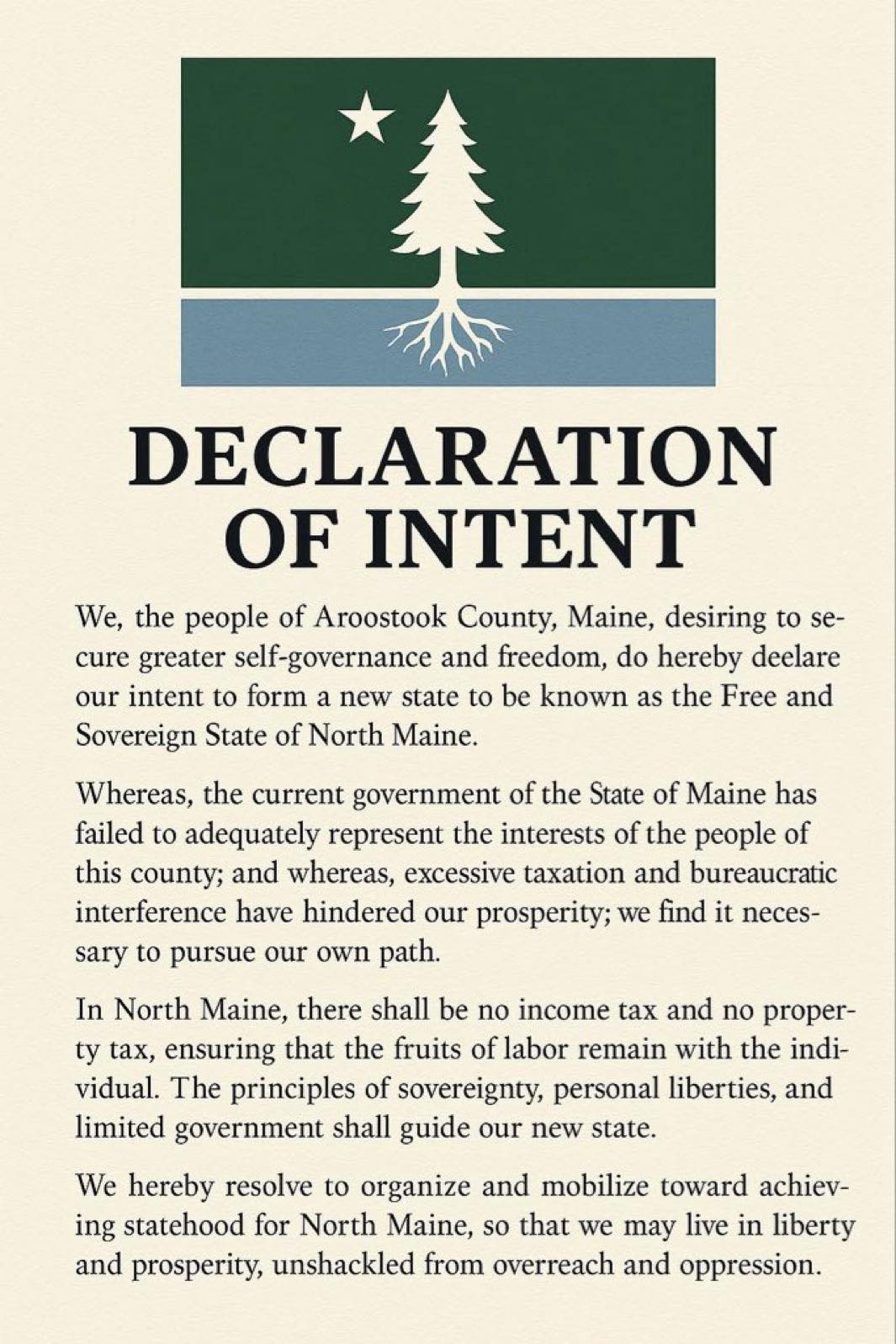A two-state solution?
Add North Maine to the list of blue-state groups who want their own state.

I saved a social media post about a new page from a couple weeks back because it reminded me of the late Maryland Eastern Shore State Senator, Richard Colburn. Back in the 1990s he had the idea of breaking the Eastern Shore away from the rest of Maryland, saying secession is “part of our nation’s history and dates back to the American colonies seceding from an oppressive British Empire that was trying to tax and regulate Americans to death.” He added that the lower two counties in Delaware were free to join in as well, but New Castle County was not invited.
In this case, North Maine is fed up with the rest of the state because secession would be, “a grassroots response to decades of cultural, economic, and political disconnect between our region and Augusta.” They join other breakaway ideas like the state of Jefferson, proposed in northern California and southern Oregon, as well as rural Oregon’s bid to be part of a greater Idaho.
Similarly, a decade ago California flirted with the idea of creating six states out of its massive area - one of which would have been Jefferson - while eleven Colorado counties voted on secession into “Northern Colorado.”
Except for the “six California” idea, these are Republican-leaning areas of “blue” states who want lower taxes and more rights and self-determination than the state governments are willing to give.
This is nothing new, though: shortly after our nation’s founding, the most mountainous portion of North Carolina and what became Tennessee wished to become the state of Franklin but could not get the federal government to agree. It’s also why several states have a small movement to go completely independent and secede entirely, but that’s not within the scope of my discussion.
Whether the Eastern Shore of Maryland and the two southernmost counties of Delaware decided to combine forces or not, their frustrations are basically a shared dislike of the mandates and dictates forced upon them by Annapolis and Dover, respectively. Those were once cooled off in a bygone era because state Senators were allocated by county and not by population - meaning rural interests had a majority in one legislative body while urban and suburban interests held sway in the other. It was a formula set up similarly to the compromise that established the federal system, where the House representation is allocated by population, but the Senate is equally allocated by state. While it may seem unfair that California and Wyoming have equal Senate representation, that was the “big state vs. small state” pact the Founders worked out. Unfortunately, at the state level the 1964 Reynolds v. Sims decision of “one man, one vote” shifted all of the power to the populated areas - hence the frustration of rural interests.
(While Reynolds v. Sims was decided in 1964, a federal District Court had ruled two years earlier that Delaware’s initial proportion of seven Senators per county was unconstitutional on similar grounds and basically forced the General Assembly to revise the state constitution at the earliest possible opportunity, with the first leg passing in 1962 and second leg coming shortly after the DGA was sworn in back in January 1963. On the other hand, because they only have state legislative elections every four years, Maryland changed their Senate from 2 per county, plus two representing Baltimore City for a total of 48, to its present district-based apportionment of 47 members in reaction to Reynolds v. Sims in time for the 1966 election. The Delaware situation was explained in Justice Harlan’s dissent.)
Perhaps a new and novel strategy these secession interests could attempt, then, is to figure out a way to bring a case to overturn Reynolds v. Sims, arguing that states should have the right and duty to set up their Senate or equivalent upper legislative body on a federal model as initially intended. (The only state this wouldn’t work for is Nebraska, which has a unicameral legislature.) To do otherwise is to subordinate the interests of rural counties to those of urban counties, making states more of a democracy than the republican form of government they were intended to have. After all, the bad precedents of Roe v. Wade and the Chevron decision have recently gone by the SCOTUS wayside, so this would be a chance to correct another wrong.
At a time when our respective states’ legislative bodies are trying to run roughshod over rural interests (for example, in the realm of green energy or marijuana dispensaries) this is a vital fight to have.
In the meantime, though, you can Buy Me a Coffee, since I have a page there now.



I wrote about this, too: https://albertcory50.substack.com/p/let-my-people-go
I didn't know about Maine, Delaware, and Maryland, though. I did find a few blue counties stuck in red states and which might like to move, so it's not 100% red counties trying to leave blue states.
Both states have to approve and the Federal government has to approve. The sticky bit is the state being diminished. I think the Feds could apply sufficient leverage on them to get them to approve, too.
Whoa… this is new knowledge. As I have written about the potential states of Jefferson and North Colorado, this coming out of Maine is fascinating.
Will be tracking this - thanks, Michael!